Over 90% of Nissan Altima owners report exceptional satisfaction with their vehicle’s performance and reliability. If you’re diving into the world of used cars, the u1001 2003 Nissan Altima sedan stands out as a beacon of durability and comfort. This model, known for its smooth ride and efficient fuel economy, has become a go-to choice for drivers seeking both practicality and style. Whether you’re commuting to work or planning a road trip, the 2003 Nissan Altima offers an experience that combines the best of affordability with the high-quality standards Nissan is known for.
Overview U1001 in Nissan Altima
Fault Code
U1001 is a communication fault code. It shows problems in the CAN bus communication. This network lets different parts of the car talk to each other.
Cars have many electronic control units (ECUs). They control everything from engine timing to air conditioning. U1001 means these ECUs can’t communicate properly.
Impact on Altima
The 2003 Nissan Altima relies on this system for smooth operation. Without it, you might see weird issues. Lights on the dashboard might turn on for no reason, or the car might not start.
It affects safety and performance. Imagine trying to drive without knowing if your car will respond correctly. It’s scary and unsafe.
Addressing U1001
Fixing U1001 should be a priority. A skilled mechanic can diagnose and solve this problem. They might need to replace damaged wires or update software.
Ignoring it could lead to bigger problems later. Your car might stop working at a bad time, like when you’re far from home.
Common Symptoms of U1001
Dashboard Lights
Erratic dashboard warning lights are a key symptom. They might flicker or light up without reason. This can be confusing and worrying for drivers.
The lights on the dashboard act like the car’s way of talking to you. When they start acting up, it’s a sign something’s wrong.
Engine Issues
Another common problem is engine stalling or difficulties starting. This can happen without warning, making it unreliable and unsafe to drive.
etimes, the engine just won’t start. Other times, it might stall in the middle of a trip. Both are signs that the U1001 code is causing trouble.
Power Loss
Loss of power to certain vehicle functions is also frequent. It might affect windows, locks, or even steering.
This loss of power isn’t just inconvenient. It can also make driving dangerous if important features stop working suddenly.
Electronics Malfunction
Unexpected behavior in vehicle electronics is another symptom. The audio system or navigation might stop working properly.
These issues can range from minor annoyances to major problems. They all point to the U1001 code being an issue.
Limp Mode
In some cases, the vehicle enters “limp mode”. This limits its performance to prevent further damage.
Limp mode means your car is trying to protect itself. But it also means you need to get things checked out fast.
Diagnosing the U1001 Code
OBD-II Scanner
Using a professional OBD-II scanner is crucial. It helps accurately read the U1001 code. This tool can pinpoint issues within the vehicle’s control units.
It’s important to use the scanner properly. A correct diagnosis saves time and money.
CAN Bus Inspection
A thorough inspection of the CAN bus system is necessary. This includes checking wires and connectors for damage or corrosion.
Small issues here can cause big problems. They often lead to the U1001 code appearing.
Auto-Electrician Consult
etimes, diagnosing this issue is complex. It’s wise to consult with a specialized auto-electrician.
They have the skills to handle complicated diagnostic procedures. Their expertise ensures a correct fix.
Causes Behind U1001 Code
Wiring Issues
Damaged wiring or connectors within the CAN bus system can lead to the U1001 code in a 2003 Nissan Altima sedan. These damages disrupt the flow of information between the car’s electronic control units (ECUs).
It might be due to wear and tear over time. Sometimes, rodents chewing on cables cause this damage. Inspecting for visible signs of wear or breaks is crucial.
Faulty ECUs
Faulty ECUs are another common cause. They are the brain behind many of the car’s functions. If they fail, it can halt communication across the vehicle’s network.
This failure might stem from internal malfunctions or external impacts. Replacing or repairing faulty ECUs often resolves the U1001 code.
Aftermarket Interference
Aftermarket installations that interfere with the CAN bus can trigger this error code. These installations might include audio systems, alarm systems, or other electronic modifications not originally part of the vehicle.
They can overload the system or cause conflicts in data transmission. It is important to ensure any added electronics are compatible with your vehicle’s system.
Solutions for Resolving U1001
Wire Repair
Repairing or replacing damaged wires and connectors is crucial. It ensures the communication within the vehicle’s network is smooth. This step often solves the U1001 issue directly.
First, inspect all wiring connected to the Control Area Network (CAN). Look for any signs of wear, tear, or damage. If you find any, repairing or replacing them should be your priority. Often, this simple action can clear the U1001 code.
ECU Update
Resetting or updating the vehicle’s ECU software might be necessary. This is especially true if the problem comes from software glitches.
To do this, take your car to a professional. They have the right tools to update your ECU safely. Sometimes, just resetting the system clears the error code. Other times, an update fixes any bugs causing miscommunication.
Remove Interferences
Aftermarket devices can interfere with your car’s CAN bus system. Removing these devices might solve the U1001 issue.
Check if you have installed any non-factory devices recently. This includes audio systems, alarms, or performance chips that connect to the car’s electrical system. If so, try removing them to see if it resolves the error code.
Labor and Cost Considerations
Repair Costs
Repairing the U1001 code in a 2003 Nissan Altima Sedan can vary greatly in cost. Typically, labor rates range from $75 to $150 per hour, depending on the mechanic or dealership. The complexity of the issue, especially if it involves intricate wiring repairs or multiple Electronic Control Units (ECUs), can push costs higher.
Parts themselves might not be overly expensive, but the labor involved in diagnosing and fixing issues related to the temperature needle or communication errors can accumulate quickly. Owners should anticipate spending anywhere from $200 to over $600 when considering both parts and labor for standard repairs.
High Costs Scenario
In scenarios where multiple ECUs need repair or replacement, costs can skyrocket. This is because each unit requires precise programming and installation, multiplying the hours needed for repair. It’s crucial for car owners to understand that these situations can elevate the repair bill significantly, sometimes exceeding $1000.
Owners should always seek multiple quotes from reputable mechanics or dealerships. This ensures they receive a fair price and quality service. Remember, cheaper isn’t always better, especially with complex electrical issues.
Quotes Importance
Getting several estimates is more than just about finding the lowest price; it’s about understanding the scope of work. Different mechanics may identify different issues or suggest varying approaches to repair. By comparing quotes, owners ensure they are not paying for unnecessary work while also gaining insight into their vehicle’s condition.
Preventing U1001 Code Issues
Regular Checks
Regular maintenance is key. It helps spot early signs of trouble in the CAN bus system. Such checks prevent bigger problems.
Vehicle owners should schedule these checks yearly. This ensures all parts work well together.
Approved Devices
Using only approved devices is crucial. Not all aftermarket devices are safe for your car.
Before adding anything, talk to a professional. They know what’s best for your vehicle.
Software Updates
Keeping software updated is another important step. It prevents compatibility issues.
Manufacturers release updates often. These updates fix bugs and improve performance.
Assistance and Support Options
Nissan Dealerships
For those seeking professional advice and repair services, contacting authorized Nissan dealerships is a wise choice. These dealerships have technicians with ASE certifications who specialize in Nissan vehicles. They can provide accurate information and solutions for the U1001 code issue.
Visitors can expect to receive excellent service. The technicians will pull the vehicle into the service area, open the hood, and perform a thorough diagnosis. They often have access to the latest technical service bulletins (TSBs) that might offer additional guidance or fixes.
Owner Forums
Joining Nissan owner forums or groups offers another layer of support. These communities are filled with experienced owners who have faced similar issues.
Members share their experiences, answer questions, and offer tips on how to address problems like the U1001 code. It’s not uncommon to find posts detailing step-by-step fixes that worked for others.
Online Help
Platforms like JustAnswer provide quick access to automotive experts online. Users can post their questions and receive answers within minutes. This option is great for those looking for a fast response without leaving home.
Experts on these platforms often have satisfied customers who appreciate being able to fix issues themselves with the right information.
Final Remarks
Navigating the U1001 code in your 2003 Nissan Altima doesn’t have to be a headache. We’ve walked you through what this pesky code means, its symptoms, and how to diagnose it. You’ve also got the know-how on fixing it, what you might spend, and how to stop it from popping up again. Plus, we didn’t leave you hanging on where to get help if you need it. This guide’s got your back, making sure you’re not alone in tackling car troubles. Remember, keeping your ride smooth isn’t just about dealing with issues as they arise but preventing them before they start. Stay proactive and your Altima will thank you.
Ready to take control? Dive into regular check-ups and keep those nasty codes at bay. Your car’s health is in your hands. Let’s make those drives worry-free again!
Frequently Asked Questions
What is the U1001 code in a 2003 Nissan Altima Sedan?
The U1001 code indicates a communication issue within the car’s network, meaning the Engine Control Module (ECM) can’t correctly communicate with other parts of the vehicle.
What are common symptoms of a U1001 code in a Nissan Altima?
Common symptoms include the engine light turning on, the car unexpectedly stalling, or experiencing difficulties starting.
How do you diagnose a U1001 code in a 2003 Nissan Altima?
Diagnosing a U1001 code involves using a professional scan tool to read the fault codes from the ECM and checking for any related wiring or component issues.
What causes a U1001 code in a 2003 Nissan Altima?
Causes can range from damaged wiring, faulty control modules, to poor connections within the vehicle’s communication network.
What are some solutions for resolving a U1001 code?
utions include repairing or replacing damaged wires, fixing poor connections, or replacing faulty control modules as necessary.
How much does it typically cost to fix a U1001 code issue in a Nissan Altima?
Labor and parts costs vary but expect to pay between $75 and $150 per hour for labor alone. Parts will add to this cost.
How can I prevent U1001 code issues in my Nissan Altima?
Regular vehicle maintenance and promptly addressing any warning lights or strange behaviors can help prevent U1001 and other codes.










